Text
Critical Annotation
The recent entries into the dossier, in addition to looking at artists, I am exploring how artists present their work. The body of work = journey which has beginning, middle and an end = experiential. The presentation is the exhibition and book, which are artworks in themselves. When conceived and executed well in addition to embodying the work, it is a means to convey another dimension, further engaging our senses. Art only thrives because of the “in person connection”.
So how does one ensure the “in person connection” - ability to interact visually (form, spatial processing), physically (form, sense of touch ) and physiologically. On the physiological, language, perception, reasoning (reflecting on the artwork) and mood (resulting in).
For artworks to be fully appreciated the presentational medium (formats and materials) need be synchronous to the subjects/topics, meaningful thought has to be given to the approach itself.
The photography exhibition, The Family of Man (MoMA 1955) often said to be the most successful photography exhibition. It has received both positive and negative reactions to the exhibition in the social/cultural studies context.
Interesting point to note, some who have been critical of the exhibition had never seen the exhibition in person. So were they misinformed, given they may have only seen the exhibition catalogue. (in future, I am keen to look at The Family of Man from an aspect of race and class, “imperialism”, “. . . as a capitalist cultural tool levering world domination at the height of the Cold War” [Allan Sekulla]).
Edward Steichen coordinated and presented the interactive visual photo essay. Interactive (physical and layout) in so much the varied size of the images, how they were hung and the layout. Viewers were able to walk through the works as how they desired, engaging the viewer. As for the scale and layout, the exhibition consisted of 503 images, works of 273 photographers/artists from 68 countries.
The presentation “engulfs” the viewer into the greater world it was depicting – “a manifesto for peace and the fundamental equality of mankind”
As I explore the presentation layers, how the content or body of work is developed is key. It is the essence.
With my work focusing on faith, culture and heritage the sharing/telling and or exhibiting the story, essence of the story needs to be articulated. The topic being multi-layered and its close to topic of humanity, its essence needs to be “lived” understood and portrayal be sensitive in nature.
How does one capture the essence, short of living it. A photograph separates us from the world. It creates a “spatial distance” but it’s time bound. Given this, how does one ensure that the photograph (image and the medium (e.g. paper) its printed on) is able to convey the next level and or depth of “voice” of the image. To convey the embodiment, possible things to consider would be the format, size, colour, type of paper, pigmentation, ink, resolution etc.
Hans Georg Berger’s work in Laos and his approach of “community involvement” where the photographer seeks to blend in into the community and works with the community and have them show him where to look, what to portray and how to portray. He went on further to look at the physical aspect of the photograph and how it best it “aligned” with the Buddhism aesthetics – square images (characteristics of Buddhism aesthetics - cosmology, art and architecture) and black and white images (offers abstraction).
The printed page is a means of recording and disseminating information and ideas, the embodiment (engagement) of the work. In photography, the printed page or the photo-book has become literary art. Photographs in a certain sequence can tell a story, as in photo essays.
Books which are “constructed” delivers content in an intricate structure which can create an emotional response. It gives the “in person connection”, a one to one engagement, conversation, moments of understanding.
Dayanita Singh, a photographer who is known for her work with different photo book formats, an art object as she refers to them. She used the book medium to showcase her photography. The art object serves as book exhibits and exhibition catalogues. In the traditional nature of books as a record. They are easily re sequenced, intermingled with her other photo-books for an exhibition.
“ I’ve always wanted to find this space between publishing and the art gallery. What I love the most about photography is dissemination, and publishing gives me that. But I also love how the art gallery can make you look at things in a very special way.” Dayanita Singh.
Having seen and physically interacted with her work, I am exploring how her approach to the book is applicable to my work.
On a recent project of making a maquette of my work titled “Beginning, End”, Azelia, book designer and I developed a book , adopting Singh’s approach the book as an art object and the format of a Japanese photo album. This work continues as there are a multitude number of areas that needs to be explored in developing and presenting a body of work.
In summary, the recent entries in the dossier are possibly tangential to some the frameworks we have discussed. However, they remain connected to the development of my work as I work through the helix through time and thought.
#critical annotation#photography#framework#hans georg berger#dayanita singh#photography exhibition#exhibition#photobook
0 notes
Text
Create art in a book form
Steidl
Printer and publisher Gerhard Steidl is highly regarded for the range of photo books and monographs of photographers and artists and their body of work. Among them are Bruce Davidson, Robert Frank, Robert Adams, Karl Lagerfeld, Dayanita Singh, Ed Ruscha, Roni Horn and Juergen Teller.
Since launching the international photo book program in 1994 has become synonymous as a publisher of choice for many photographers. Each of the books that Steidl prints is known for its quality in terms of individual design and its production. He pays particular interest to the paper used in his books. He is also know for being personally involved in all the aspects of the production process, working closely with the photographer and his production team. Steidl is known for being focused on every detail of the book - a perfectionist.

In addition to being a printers and publisher, Steidl is a curator, conceiving and producing photography exhibitions worldwide.
Working with printed book ( 2 dimensions ) and photography exhibitions (3 or multidimensional ) each lends to the other and only enhances each area individually. They intrinsically linked to ensure the “living” and “sharing” of the body of work.
Steidl as a publisher can be said to work with the book as work of art which are semi-mass-produced. The published books are not cheap nor are they expensive although the runs maybe limited. In many instances the first published books have become collectors items give the numbers, form and the detail of its production.
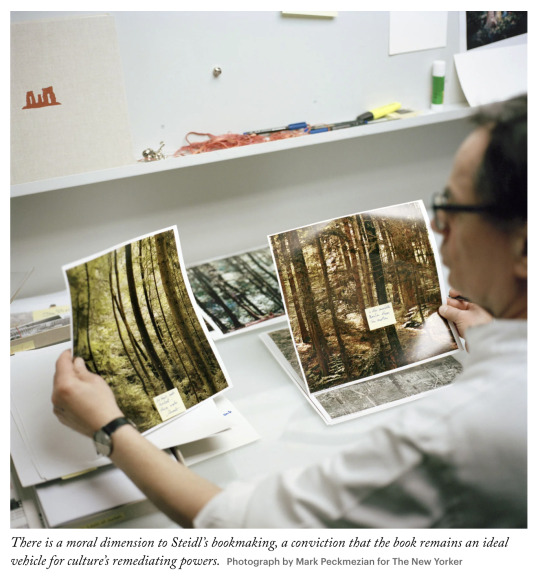
His books are of a size that is easy to hold and read compared to some books by Taschen which have a number of large sizes.
“If you read a book, or a visual book—for me, it is all reading—or if you are in a gallery or a museum, and the curated show was done by an educated person, that educates you visually”. Steidl.
Source: https://www.newyorker.com/magazine/2017/05/22/gerhard-steidl-is-making-books-an-art-form
0 notes
Text
Exhibitions come and go, the book stays forever
Dayanita Singh
Dayanita Singh, photographer who uses the book form (Book Objects) to share her work. Some of her work / books, they can be “reappropriated” to be art objects in an exhibition. She has been able to converge the 2 forms. The book objects are a physical form (wooden box frames) which hold about 30 cardboard mounted photographs. They can be taken as form of books, art objects and exhibition catalogues.
This format allows her to resequence her works and images to convey different themes.

Source: https://www.tate.org.uk/art/artists/dayanita-singh-18238
Dayanita’s view is that any photograph taken needs to be disseminated. How best to disseminate it then in a book form. The book stays forever. It gives the photograph another life. The tactile sense of the books gives a connection to the image, depending on the material used can give a sense of “feel”.

Why do we do what we do as an artist? Is it for ourselves, for a handful few or to be shared.
#Dayanita Singh#photographer#book objects#photo book#book#form#photography exhibition#art exhibition#b&w
0 notes
Text
Telling a story & presenting in context
Hans Georg Berger
In a photograph there are 3 things that have to come together place, people and time. If we step back and look at what is art (photography included) . . .
it's where we connect with the physical and emotions. And intellectualising of what we feel, see and observe.
it's where the sense of touch is experienced through the eyes, as textures and shapes are felt through seeing
+ we are made of memories
A photograph is an embodiment of an event experienced. It captures that specific act in a place, people and time. It's a discrete slice of time but missed (or may have) the larger "picture".
Hans Georg Berger has produced a series of long-term photography projects involving world religions, including Theravada Buddhism in Burma, Cambodia, Laos, and Thailand, as well as Shiite Islam in Iran.
Berger's approach of "community involvement" where the photographer seeks to blend in into the community and works with the community and have them show him where to look, what to portray and how to portray. A dialogue with the subject/s.

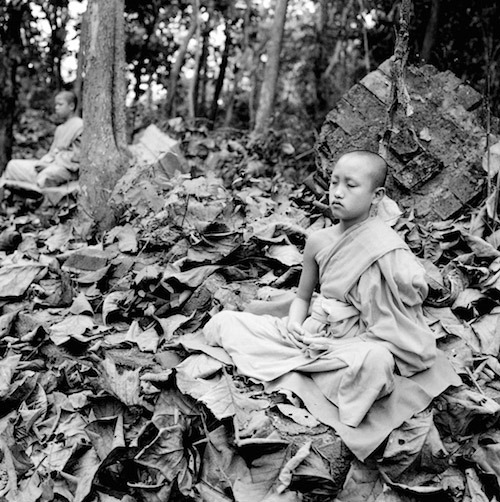
In addition to the immersion, Berger worked with the monk community on the technicalities of the photograph (as seen above);
Square images – characteristics of Buddhism aesthetics - cosmology, art and architecture (eg. Stupas have a square base)
B&W images – offers abstraction. Focuses on the subject, form, textures and composition. Makes us pause and look closely
Adopting this approach, it gives the photographer access and better insight to the message/work the photographer is trying to capture, story to tell.
0 notes
Text
America Gothic
Gordon Parks
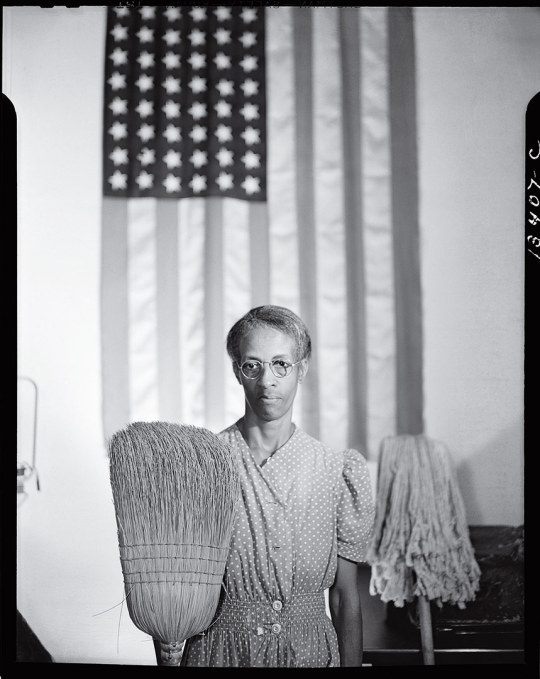
Park’s image of Ella Watson (above) who worked in the Farm Security Administration (FSA).
Watson shared with Parks her life of struggle in a “land of the free”. The image by Park portrays the challenges the African Americans face by the juxtaposition of Watson with the broom and mop in her hands (life of struggle) with the American flag in the background (land of the free).
Ella Watson United States Government Charwoman. https://www.loc.gov/collections/fsa-owi-black-and-white-negatives/articles-and-essays/documenting-america/ella-watson-united-states-government-charwoman/
Park’s image followed the style (parody)of Grant Wood’s 1930 painting (below).

#american gothic#gordon parks#fsa#ella watson#grant wood#painting#1942#photograph#1930#time#100 photographs#influential
1 note
·
View note
Text
From my land to the Planet
Sebastião Salgado
Salgado is known for his black and white images, social documentary on social, geographical and humanity. The black and white images depicts the core of our being, where colour can be deceptive. His work in many ways depicts how we are driving the world and ourselves (humanity) to destruction. It’s a documentary of our times.

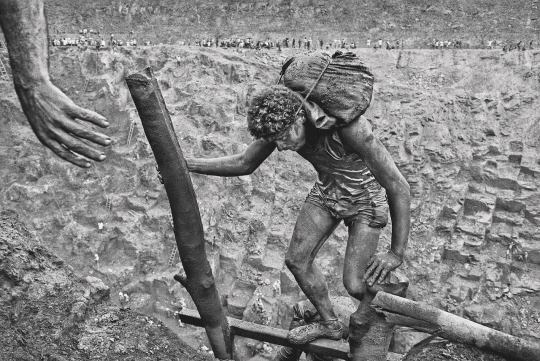
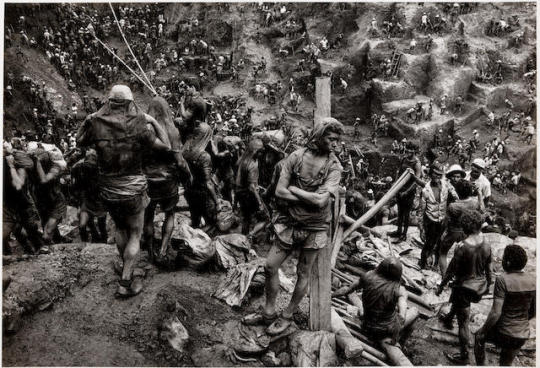
Above: Images form the book “Gold”, the Brazilian gold rush - Serra Pelada, world’s largest open air gold mine.
“… with black and white and the entire range of greys, I can concentrate on people’s intensity, their attitude, their gaze, without all this being disturbed by colour”, Sebastiao Salgado from his book From my Land to the Planet.
His projects are long term projects where he spends significant amount of time with the society or the environment he is working in to tell the story. He merges himself to be part of what is happening. In this manner, there is a higher level of intimacy and sensitivity in the images and the photo essay.
Most recent work was on the topic of the environment, Genesis. It depicts communities that still live as one with mother Earth, practicing their ancestral traditions and culture. These are untouched parts of the world, approximately 46% of the world is still untouched. In addition to human aspects, it captures landscapes and wildlife that have not been touched by humans and the developed world.
“Genesis is a quest for the world as it was, as it was formed, as it evolved, as it existed for millennia before modern life accelerated and began distancing us from the very essence of our being,” said Lélia Wanick Salgado. “It is testimony that our planet still harbors vast and remote regions where nature reigns in silent and pristine majesty.” [ https://www.icp.org/exhibitions/sebasti%C3%A3o-salgado-genesis ]

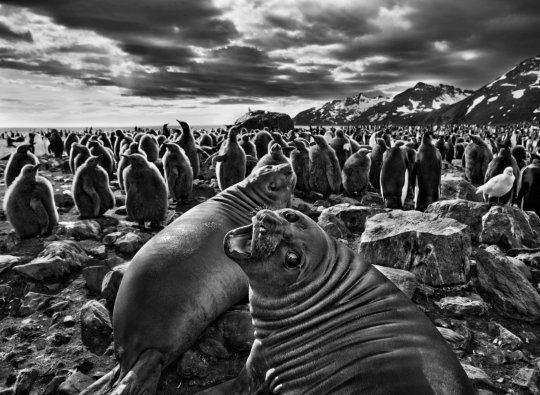

Above: Images form “Genesis”, unchanged landscapes and people of the world.
His purpose, Salgado decided, “would not be to photograph what is destroyed but what is still pristine, to show what we must hold and protect.” He likes to quote a hopeful statistic: “45% of our planet is still what it was at the beginning.” [ https://time.com/3798068/in-the-beginnings-sebastiao-salgados-genesis/ ]
Having seen a few of his books, I strongly feel that the scale or intensity of the work does not come across when published in a standard book size. One would be the “Gold”, depicting a world’s largest open-air gold mine, employing about 50,000 miners in appalling working conditions.
The body of work needs space for one to be able to fully appreciate the immensity of the world and the issues being highlighted. One needs to be “absorbed” into the visual to get a sense of the scale of issue or topic being presented.
#salgado#Sebastião Salgado#photography#photographer#b&w#social documentary#photo essay#genesis#gold#book#photobook#immersion#long term#projects
0 notes
Text
Mingei -“ hand-crafted art of ordinary people"
“Mingei” an art form developed in Japan in the early 1920s by Yanagi Soetsu, Hamada Shoji and Kawai Kanjiro. Yanagi-san was a philosopher and Hamada-san and Kawai-san were potters.
The “ideology” of “mingei” as put forward by Yanagi-san that art was not only that what was created by artisans but ordinary daily objects made by ordinary nameless person have their own beauty.
Prior to “mingei”Japan was an isolated country (Edo period ~ 300 years ) and during this time it had developed its unique aesthetics like “shibusa” (simple, subtle, imperfection) and “iki” (aesthetic ideal, urban, stylish, simple, sophisticated). Given it’s isolation, theses aesthetics later developed into “mingei”. This was in opposition to the Western influence that had started to infringe into Japan after the Meiji restoration.
In the first book book on “mingei”, 1928, he put forward that daily objects made by the common people were "beyond beauty and ugliness”. [Yanagi Sōetsu, Kōgei no Michi (The Way of Crafts). Selected Works, Volume 1. Tōkyō: Nihon Mingeikan, 1955.]
For an object to be considered “mingei”, the object had to meet a certain set of criteria, cumulating to beauty;
1) Made by unknown craftsmen
2) Made of natural material and hand made
3) Using traditional methods and design
4) Simple in design
5) Form and design but functional
6) Inexpensive
7) Easily re produced
In this regard, art can be created by all not just by artists or artisans. It can be created and appreciated by non artisans.
The connection between the work of art and the individual is our sensory. That sensation is what makes the work appreciated. All of us have this sensory capability in one form or other. Without this common ground of connection, there will be no art.
Art in a true form is basic and pure. The energy of the maker is what makes it work.
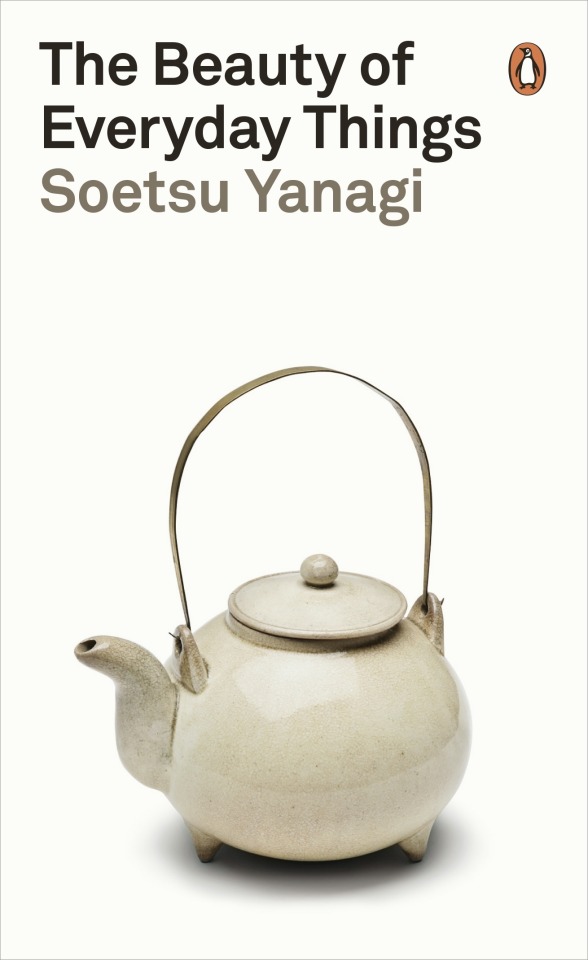
6 notes
·
View notes
Text
The Family of Man
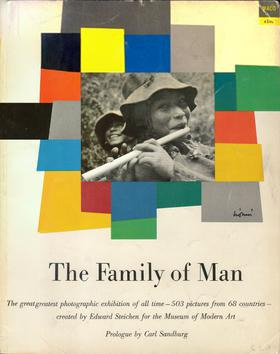
The Family of Man exhibition was held at MoMA in 1955, curated by Edward Steichen. It brought together works of photographers from around the world. The aim was to share aspects of human life and the recording of human relations. It consisted of 503 images from 68 countries by 273 artists. It toured the world for 8 years across 37 countries and was seen by more than 9 million people.
“Steichen had invited photographers to submit photographs for consideration, explaining that his aim was to capture “the gamut of life from birth to death”—a task for which, he argued, photography was uniquely suited.” https://www.moma.org/calendar/exhibitions/2429
MoMA Press Release

Source: MoMA
The exhibition had a mixed reviews. The intent was there but given the times, it was potentially a means of conveying / comparative visual of how advanced the Western society was in comparison to the rest of the world. This considering the political and cultural settings of that time.
Roland Barthes viewed the exhibition as dramatisation of an ideological message. In his book Mythologies (1956), he called it "conventional humanism," a collection of photographs in which everyone lives and "dies in the same way everywhere ." "Just showing pictures of people being born and dying tells us, literally, nothing.”
Separating the intent, the reviews, the interpretation of the exhibition, one has to give due credit to Steichen for conceiving the idea of the exhibition and the photo essay itself. It had made photography a mainstream medium and first steps to an art form.
Having been through the catalog of the exhibition, what is of interest are the mix of images and the captions. In many ways it did not show kindness but more of hardship of lives. But one needs to ask if this was truly the state of the world at that time.
If it was, it serves as documentation of culture and heritage of society at that time. Pictured by individuals (photographers) who felt that the images that they were making was important to convey a point of view.
“ There is only one man in the world and his name is All Men. There is only one woman in the world and her name is All Women. There is only one child in the world and the child's name is All Children.
People! flung wide and far, born into toil, struggle, blood and dreams, among lovers, eaters, drinkers, workers, loafers, fighters, players, gamblers. Here are ironworkers, bridge men, musicians, sandhogs, miners, builders of huts and skyscrapers, jungle hunters, landlords, and the landless, the loved and the unloved, the lonely and abandoned, the brutal and the compassionate — one big family hugging close to the ball of Earth for its life and being. Everywhere is love and love-making, weddings and babies from generation to generation keeping the Family of Man alive and continuing.
If the human face is "the masterpiece of God" it is here then in a thousand fateful registrations. Often the faces speak that words can never say. Some tell of eternity and others only the latest tattings. Child faces of blossom smiles or mouths of hunger are followed by homely faces of majesty carved and worn by love, prayer and hope, along with others light and carefree as thistledown in a late summer wing. Faces have land and sea on them, faces honest as the morning sun flooding a clean kitchen with light, faces crooked and lost and wondering where to go this afternoon or tomorrow morning. Faces in crowds, laughing and windblown leaf faces, profiles in an instant of agony, mouths in a dumbshow mockery lacking speech, faces of music in gay song or a twist of pain, a hate ready to kill, or calm and ready-for-death faces. Some of them are worth a long look now and deep contemplation later. “ text panel commentary by Carl Sandburg ( https://en.wikipedia.org/wiki/Carl_Sandburg )
Sandburg also provided the prologue for the exhibition catalogue.
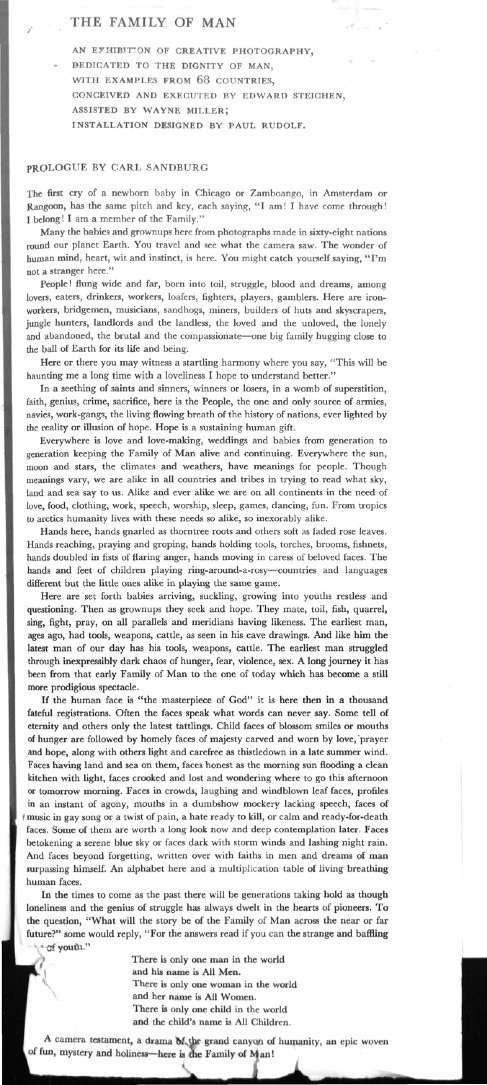
Source: MoMA
As we read Sandburg’s prologue, the intent was to share what is us as humans are about. Did the exhibition share or convey the common need to humans or did it draw a divide.
Some may argue that critics being critics were and are trying to find fault in the depiction of society of then. Some are using the lenses (perspectives) of today to compare to what was happening then. The need is to understand we as human are evolving. The rights of yesteryears are the wrongs of today and possible vice versa.
It could be but who is to say. It is up to the viewer of the exhibition of then or us of today. Today, we are only able to the see reprints of the catalogue or information available to us to form their own thoughts. We do not have the opportunity to be immersed in its physicality (of the exhibition) the juxtaposition of images, the tactile senses (seeing, feeling, touching, engaging) of being there with fellow humans, interacting with the images.
In both times then (when the exhibition was taking place in NY and around the world) the individual would have to draw on their own knowledge of the times, history and be reflecting upon their own world experience to be able to conclude.
MoMA 1955 installation images. https://www.moma.org/calendar/exhibitions/2429?locale=en#installation-images
Screenshot of the installation images page
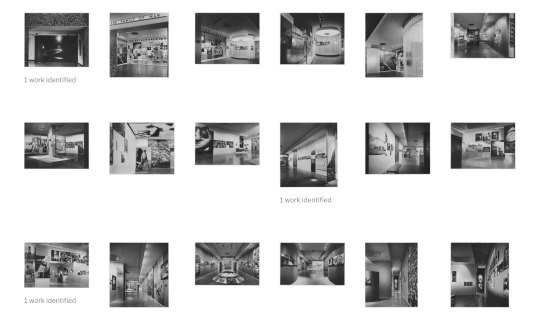
Other references: https://steichencollections-cna.lu/eng/documentations/1_the-family-of-man-in-the-21st-century
To explore further : how does Steichen’s “photo essay” relate to the world today. Is there a parallel (if so what and how) or is it just a time shift has taken place. We have not changed.
0 notes
Text
Reading a book
Not sure where I read this . . “The only sense you use to read a book is your sense of sight, yet your imagination transforms two-dimensional words into an entire world.”
How does it work with photo books and visual documentary?
0 notes
Text
Critical annotation
In the current semester, exploring (interpreting, understanding, relating) the different frameworks and the class discussions, it has made me relook at my area of focus and the approach. My focus is social documentary of the heritage of society, culture and faith. All of which are closely linked and intertwined. At times it’s an extrapolation from one to the other. Starting with faith, to identity how it is cross-referenced in the recording of time, place and people.
The dossier is an exploration (tries to) of how does one use the frameworks. But in reviewing and reflecting upon my current dossier, it is more of gathering of associated “interests” and exploration of some basic tenets. It offers a thinking platform, melding of approaches and ideas.
I see the frameworks as a means of stimulation to what exists and offers a spring board to evolving the idea or approach of my work. I believe the approach has to be intuitive not solely based on intellectually constructed approach i.e. set of rules that dictate the thinking. . . personal way, interpretation of telling the story yet connected with all. The frameworks offer cognitive connection – e.g. memory, social cognition and judgement.
The work of Roy De Carava and Langston Hughes “The Sweet Flypaper of Life” a photographic visual literature set in Harlem. The photographs of De Carava and the words of Hughes set the stage. The story is narrated through the eyes of one grandmother, Sister Mary Bradley. As one reads it , one refers to the “codes” indoctrinated/ learned over one’s life to interpret the story, social conventions. Harlem in early 40’s and 50’s was home to a struggling working class and a rising middle class. In broader terms when one mentions Harlem, its associated with the darkness of society.
In De Carava’s work, the story was put across through photographs and words of persons who lived in that time. In my work, as I develop the thinking and approach, it would need to be narrated over a span of time. Faith has evolved over the centuries. Some practices remain the same but with nuances adopted for this day and age. How does one capture its practice and evolution in a visual narration.
As I explore the works of photographers and writers, I am exploring the variety of ideas and approaches to narrate the story. The answer (if I can call it that) I am seeking is it best to express what came to me . . . an intangible feeling of trying to connect it all. As I develop the work, I come across other threads that take me down another path . . possibilities and stories. What I see happening is the initial theme evolving. It will continue to evolve but then the question is when does one stop . . .
The dossier is a collection of ideas, stories and serves as a “thinking platform” (as mentioned earlier). It is a living document through which I travel through back and forth – a helix through time. Along this helix, are a collection of data points (information) that are being gathered, reflected upon and ideas evolve.
The purpose is to continuously develop the ideas and bring together the visual [make the images] + narrative [research + references. . . ] = richer body of work. Body of work = journey which has beginning, middle and end = experiential
Like flash fiction stories, it needs to touch all of the elements, all within the strict “word count”. The “word” limit provides the creative challenge. The words in a visual vocabulary can be the number of photographs . . .
0 notes
Text
What tells a story
Photographers are like storytellers, if they can piece together shards of time, the emotions, nuances and undercurrents to convey the essence.
Gordon Parks work spanned decades as a photographer, storyteller, musician and later in life as a film maker, the movie Shaft (1971). His work document happenings in time share about humanity, question, and at time provoke. Give the time America was going through, the injustice faced by the black Americans. What he left us is a body of work (early 1940s into the 2000s ) about American life and culture.
“I’m an objective reporter with a subjective heart,” proclaimed Gordon Parks. “I can’t help but have a certain kind of empathy…. It’s more or less expressing things for people who can’t speak for themselves...the underdogs...in that way I speak for myself.”
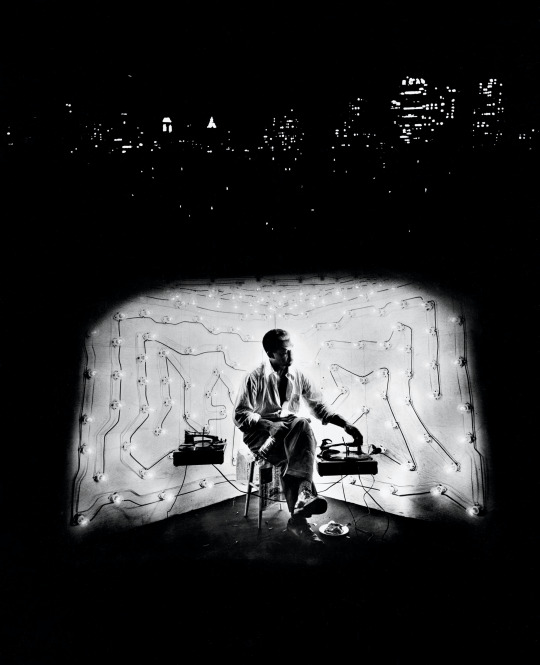

Earlier this year, MoMA acquired 56 Photographs from Gordon Parks’s Groundbreaking 1957 Series “The Atmosphere of Crime”
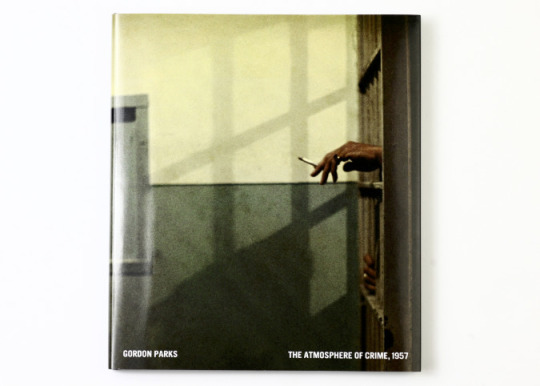

Book Review: Atmosphere of Crime, https://museemagazine.com/culture/2020/7/2/book-review-atmosphere-of-crime
0 notes
Text
“A window covered with raindrops interests me more than a photograph of a famous person,” Saul Leiter
Leiter was son of a rabbi. He left Jewish theological study at 23 and moved to New York to pursue painting. Leiter met Richard Pousette-Dart, who was then experimenting with photography. It was Leiter’s introduction to photography. He started with black and around 1948 Leiter had begun to shoot using Kodachrome 35 mm film past its sell-by date. He focused on street scene and his friends. He spent most of his time photographing the East Village, NYC.
His colour photographs were similar in a quality (mood) to that of paintings, a painterly feel that stood out. Added to it was the focus on form and its composition. While working on photography, Leiter continued to paint.
His distinctive style could be attributed to him seeing the composition and texture of his photography through the lens of painting.
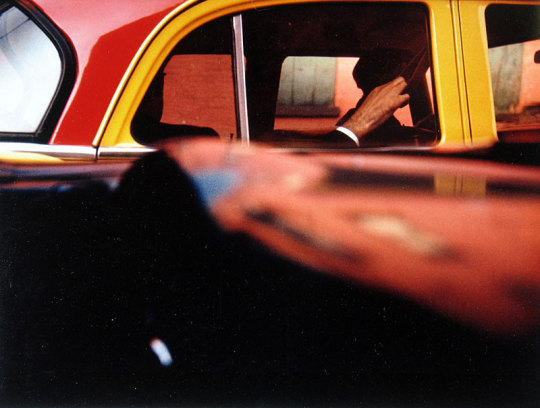
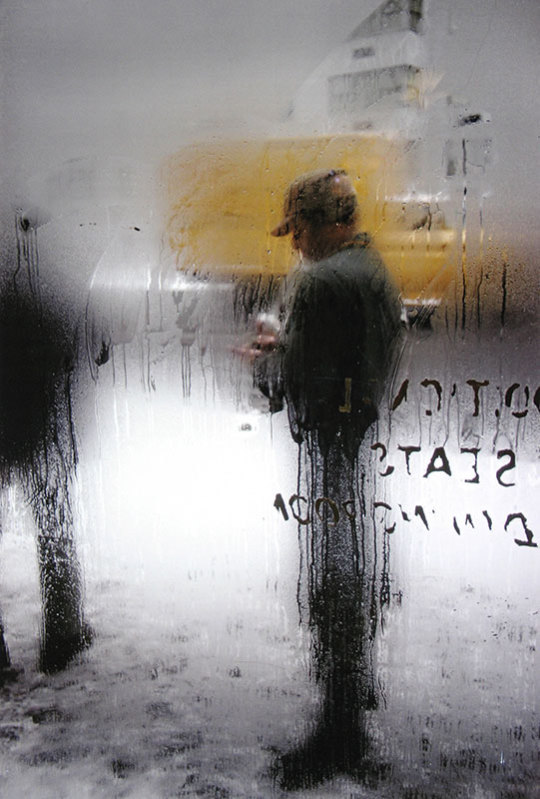

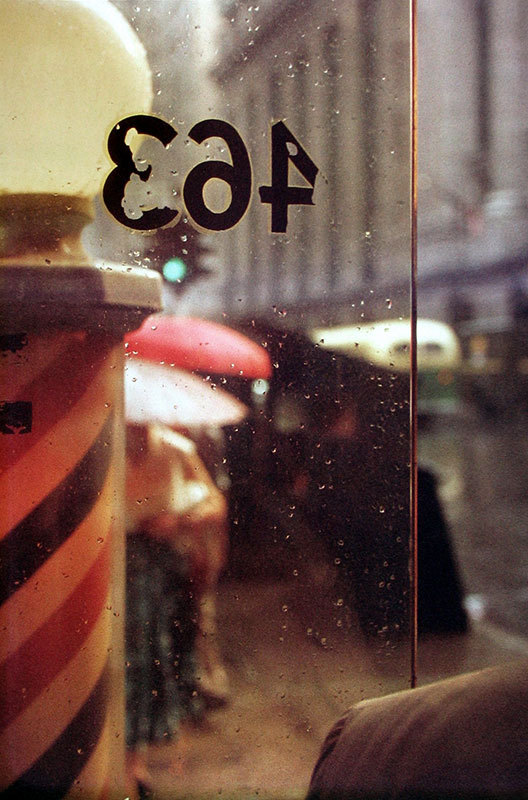
The body was work was published in 2006 by Steidl Verlag published Saul Leiter: Early Color.

In No Great Hurry: 13 Lessons in Life With Saul Leiter (2013), directed by Tomas Leach
vimeo
0 notes
Text
The Cosmic Dance and Symbolism
As I explore the areas of heritage of society, culture and faith, in a recent class, we had discussed Codes, a 'system of explicit social conventions’. For the discussion, I put forward the Indian classical dance form Bharatanatyam. The term Bharatanatyam is a combination of bha stands for bhava (feelings, emotions [expression]), ra stands for raga (melody, framework for musical notes [music]), and ta stands for tala (rhythm). The term Natya is a Sanskrit word for "dance".
The combination of bhava, raga, tala that each convey distinct meaning through the use of hand/fingers , movement of the eye, gesture, movement overall and the accompanying music (Indian classical instruments).
It has a very rich “language” of expressions.
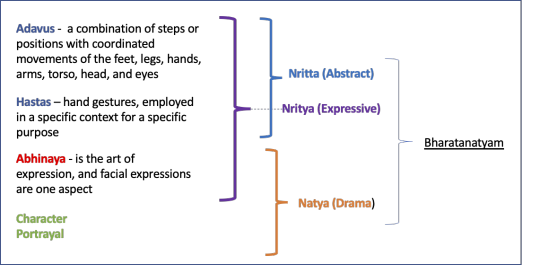
Bharatanatyam is known for its grace, purity, tenderness, and sculpturesque poses.
In the Hinduism, Lord Shiva also know as Nataraja is the god of this dance form. As Nataraja, he is the cosmic dancer. His dance is considered the source of creation, preservation and dissolution of the universe. In one aspect it’s interpreted as to release men from illusion of the idea of “self” and the physical world.
Bronze statue of the form of dancing Shiva;

The form of dance associate with Shiva is know as Tandava. There are 2 forms, Rudra Tandava (God of constructive destruction, transforms into his most vicious form while performing this Tandava. The Rudra Tandava often symbolises the destruction of the cosmos. It also signifies the release of the suppressed anger that germinates within. Most people usually take 'destruction' in the literal sense, but it has a more profound meaning. Shiva, the destroyer, annihilates the evil that seeks refuge within you, to make you worthy of attaining salvation, and relieve you from the cycle of birth and death. And the destruction caused by Shiva is constructive because it paves the way for the arrival of the new in the physical world. The world that we live in is bound by time and space, and we are subject to the cause and the natural effect.) and Ananda Tandava (the dance of bliss where the intrinsic nature of Shiva emerges as Shivam where he is in his purest form - Satchidananda. A cause and its effect do not bind this experience of pleasure. This feeling of ecstasy germinates deep within and is untouched by the mundane world. The Ananda Tandava by Shiva denotes the purest aspect of his being.)
Some forms of Shiva’s dance;
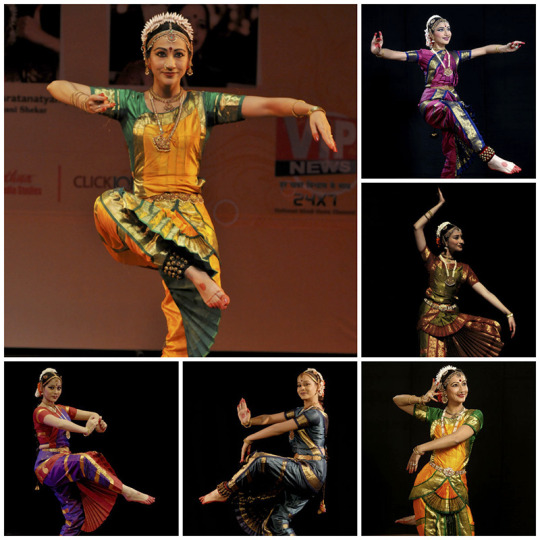
https://kalyanikalamandir.com/blogs/three-forms-of-shivas-dance/
In the Golden Hall of Chidambaram (Hindu temple in south India https://en.wikipedia.org/wiki/Nataraja_Temple,_Chidambaram ), Shiva is in the form of Nataraja.
In this and many Hindu temples you see the artworks and the various poses of dances of Shiva’s Tandava.
This dancing form of Shiva can be seen in Bali, Cambodia as well as Central Asia.
In most societies the culture and faith are inexplicably connected.
“ Dance as a Way of Being Religious” by Anne-Marie (Anjali) Gaston and Tony Gaston. Book - The Oxford Handbook of Religion and the Arts
Abstract - Dance has accompanied religious ceremonies and sacred rites since prehistoric times. Most religions have included dance as part of worship at some period or in some places. However, because of its association with fertility and its celebration of the body, dance has equally been proscribed at times in different religions. Historical data on the use of dance in Christian rites indicate wide fluctuations in acceptance over the centuries. The presentation of dance as part of worship was highly developed in India, where dancers were employed by Hindu temples for many centuries. Such dances were highly formalised and required long training, and were largely the preserve of a specific community (caste) of dancers and dance-associated musicians. In the last century the movement for Sacred Dance has sought to revive and promote religious dances, creating a diversity of hybrid and innovative movement styles. Dance as a form of sacred art continues to evolve and diversify.
https://www.oxfordhandbooks.com/view/10.1093/oxfordhb/9780195176674.001.0001/oxfordhb-9780195176674-e-010#oxfordhb-9780195176674-e-010-div1-11
Further topic to explore - Artistic Ways of Being Religious
0 notes
Text
The Sweet Flypaper of Life

“The Sweet Flypaper of Life is the story of Black love: of family and community, of life and death, of the rich textures in the tapestry of daily life that forms our sense of self and the bonds we bear on this earth “ by Miss Rosen, June 18, 2019. https://www.featureshoot.com/2019/06/celebrating-the-sweet-flypaper-of-life-in-roy-decaravas-centennial-year/
“Roy DeCarava and Langston Hughes celebrated the art of living through difficult times in “The Sweet Flypaper of Life.”” by Fayemi Shakur, Dec 5, 2018. https://www.nytimes.com/2018/11/23/lens/illuminating-black-joy-black-love-and-resistance-in-harlem.html
The Swee Flypaper of Life was about everyday life in an urban setting of Harlem in the 40’s and 50’s.
The photographs by Roy De Carava and the words of Langston Hughes potray’s life through the eyes of a grandmother, Sister Mary Bradley. It describes the going ons in the neighbourhood. Roy’s photos with Langston’s words convey a sense of being present, a reality, convergence of space and time.
It is how Hughes uses Sister Mary to be the narrator of the story guiding us about the life around. “Tenements torn down and project houses building,” writes Hughes in the resigned voice of Sister Mary.
The words are brought to life by DeCarava’s interesting and complex / layered images. Complex in the sense of simple images that’s makes one ponder eg.
Image accompanied by the text “Some folks selling, other folk buying”, page 76.
Image accompanied by the text “Yes, you can set in your window anywhere in Harem and see plenty. Of course, some windows is better to set in than any mainly because it’s better inside” on page 84, in the book, The Sweet Flypaper of Life, 4th edition 2018.
The book draws upon 2 persons with differing background and interest and what melds is a narrative of a complex time in history and for the people. Conveying the sheer joy of living and lives going by. It builds a strong visual image of people, time and place.
#roy decarava#the sweet flypaper of life#photographer#harlem#people time place#book#photobook#photoessay
1 note
·
View note
Text
Signs in Society, Culture and Faith
In pursuing the visual documentation of heritage of society, culture and faith, one aspect surfaces repeatedly in many places or aspects is the use of signs.
Signs have a predominant part to play in all religions. It is used to signify and or represent a form and or to convey meaning.
Semiotics defines a sign as anything that creates meaning. It’s anything that can be used to represent something else.
Ferdinand de Saussure, the other founder of semiotics saw signs as the basic unit of meaning and he defined two parts of signs.
• Signifier — The form of a sign. The form might be a sound, a word, a photograph, a facial expression, a painting of a pipe, etc.
• Signified — The concept or object that’s represented. The concept or object might be an actual pipe, the command to stop, a warning of radioactivity.
Peirce clarified further that the form a sign takes, it’s signifier, can be classified as one of three types an icon, an index, or a symbol.
• An Icon has a physical resemblance to the signified, the thing being represented. A photograph is a good example as it certainly resembles whatever it depicts. Physical resemblance to its object (that which it brings to mind)
• An Index shows evidence of what’s being represented. A good example is using an image of smoke to indicate fire. sensory feature that correlates with and thus implies of “points to”. Also known as natural signs. This have to be learned what it’s the association.
• A Symbol has no resemblance between the signifier and the signified. The connection between them must be culturally learned. Numbers and alphabets are good examples. There’s nothing inherent in the number 9 to indicate what it represents. It must be culturally learned. a connection between sign and meaning that must be culturally learned eg. Alphabetical or numerical
In Hinduism, there is great use of symbols where the connection between them is learnt. For example, Om (or Aum, ॐ) is the sacred sound symbol that represents Universe; the ultimate reality (Brahman).
youtube
Given the importance of Symbols in Hinduism, the understanding and visual representation (photograph of its use and representation) is key in conveying its tradition, practices, way of life and images through which the gods are envisioned.
Extrapolating from this point, from religion (Hinduism in this case) to other connections / exploration of narratives and arts - rituals, pilgrimage and festivals.
Areas/topics to explore;
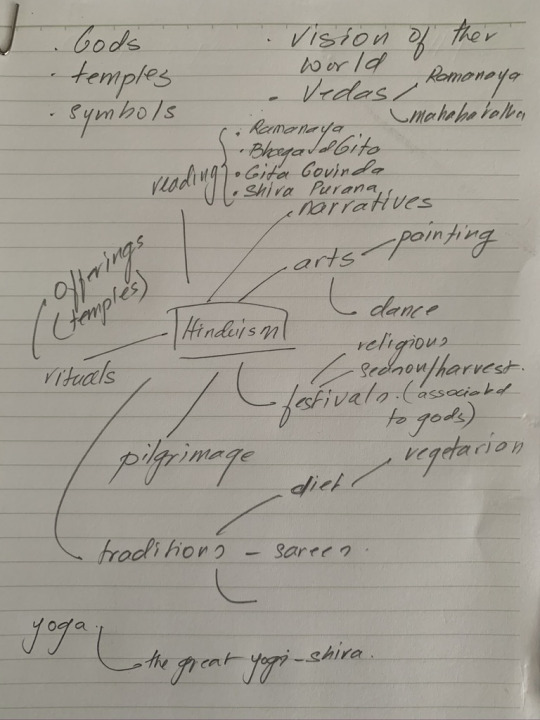
0 notes
Text
Note keeping and notebooks
Over the years, I have tried many times to keeping a notebook. Ended up buying a variety of notebooks (mainly for their design, paper etc.) but never using them as they are beautiful by design, texture and smell.
Now as I work (and grow in ) on my photography, I am compelled to keep a notebook - to collect bits of ideas, information, references, thoughts, notes on interesting conversations, anecdotes etc. Anything that will further fuel my thinking and practice.
Once again the research starts how best to approach keeping a notebook. While doing my research I am across an article mentioned by Joan Didion’s essay, “On Keeping a Notebook”.
Didion has defined a writer as “a person whose most absorbed and passionate hours are spent arranging words on pieces of paper. I write entirely to find out what’s on my mind, what I’m thinking, what I’m looking at, what I’m seeing and what it means, what I want and what I’m afraid of.” She has also said that “all writing is an attempt to find out what matters, to find the pattern in disorder, to find the grammar in the shimmer. Actually I don’t know whether you find the grammar in the shimmer or you impose a grammar on the shimmer, but I am quite specific about the grammar—I mean it literally. The scene that you see in your mind finds its own structure; the structure dictates the arrangement of the words. ... All the writer has to do really is to find the words.” However, she warns, “You have to be alone to do this.”
Source: Joan Didion , Essay, “On Keeping a Notebook”.
Reading the article, what is interesting is the way she looks at writing “. . . .to find out what’s on my mind, what I’m thinking, what I’m looking at, what I’m seeing and what it means, what I want and what I’m afraid of.”
How or can this parallel (thinking) be applied to photography - an approach . It begs the question, what and how can I make sense of it for my practice, what “lessons” can be learnt from her words.
The written word and photographs do have a close link. Without a photography we only have words to describe to share a visual. Then came along photography and the adage “A picture is worth a thousand words”.
From exploring on how to keep a notebook (still working on that), it was an interesting tangential departure from the objective but possibility an interesting learning how to look at things differently - perspective. What art making is all about.
. . . to explore, how would/can I adopt / apply Joan Didion’s approach to writing to developing my work which is close to documentary photography.
0 notes
Photo
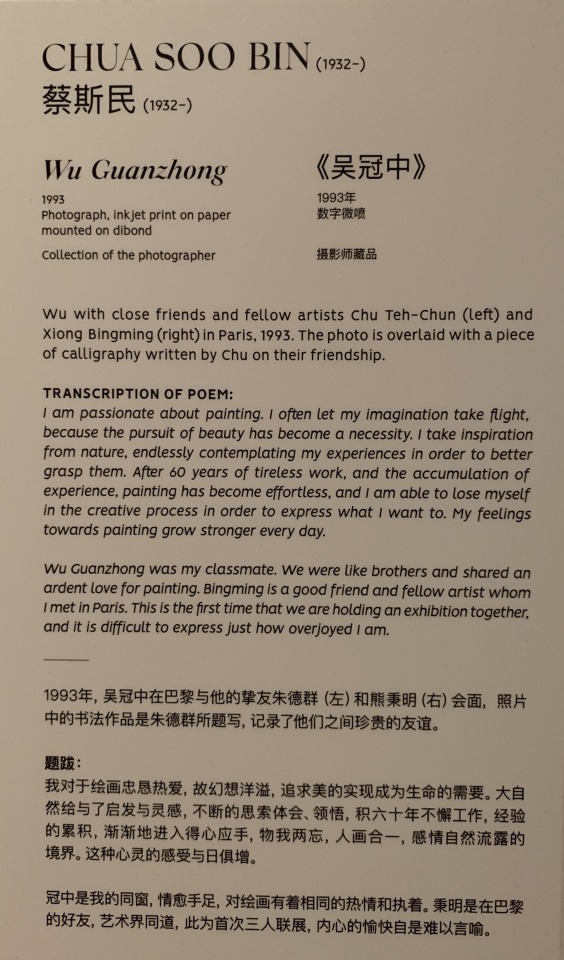

Recently I attended a photography exhibition at the National Gallery, Singapore on the photographer Chu’s Soo Bin. With a background of commercial photography (eg. Singapore Airlines) he had moved into doing his own project. Over a number of years he photographed the famous Chinese artist .
In the above image the calligraphy poem expresses many artist of the past who “tireless work and, the accumulation of experience . . Lose myself in the creative process”. They lived their passion. As for many artist today, there are the commissions , the art markets who dictate “success”.
In any for of art is it an innate “ability” that needs to be worked at, experience to excel. Many ways a “self apprenticeship”
16/5/20 - In exploring further into Chua Soo Bin’s in terms of his approach and work, I can across the following where he shares that background to the image above and couple of other works.
The Stories Behind the Portraits | Chua Soo Bin: Truths & Legends
youtube
0 notes